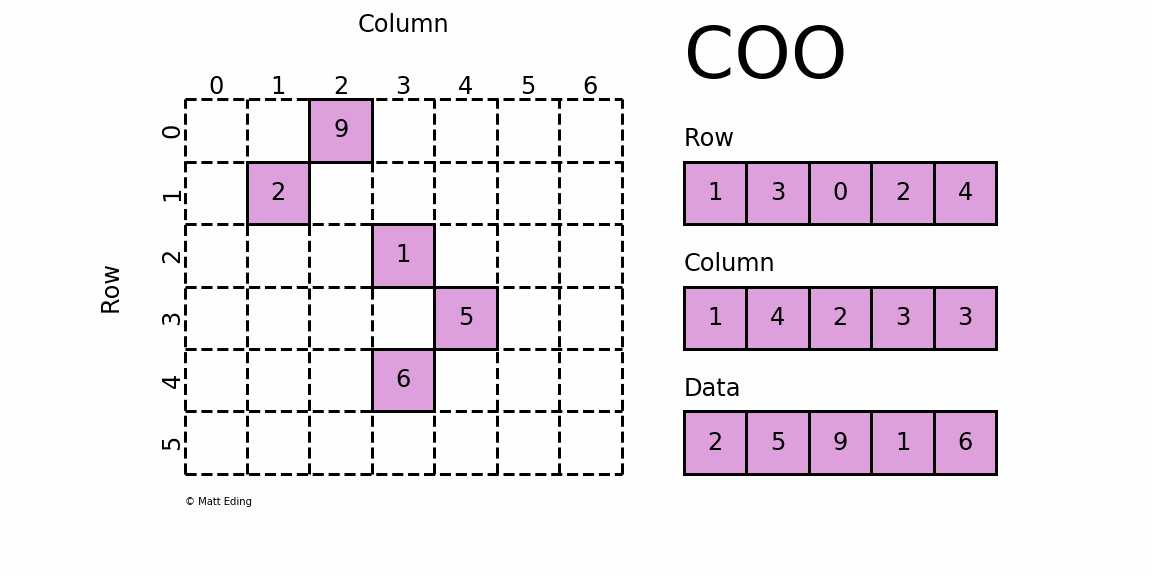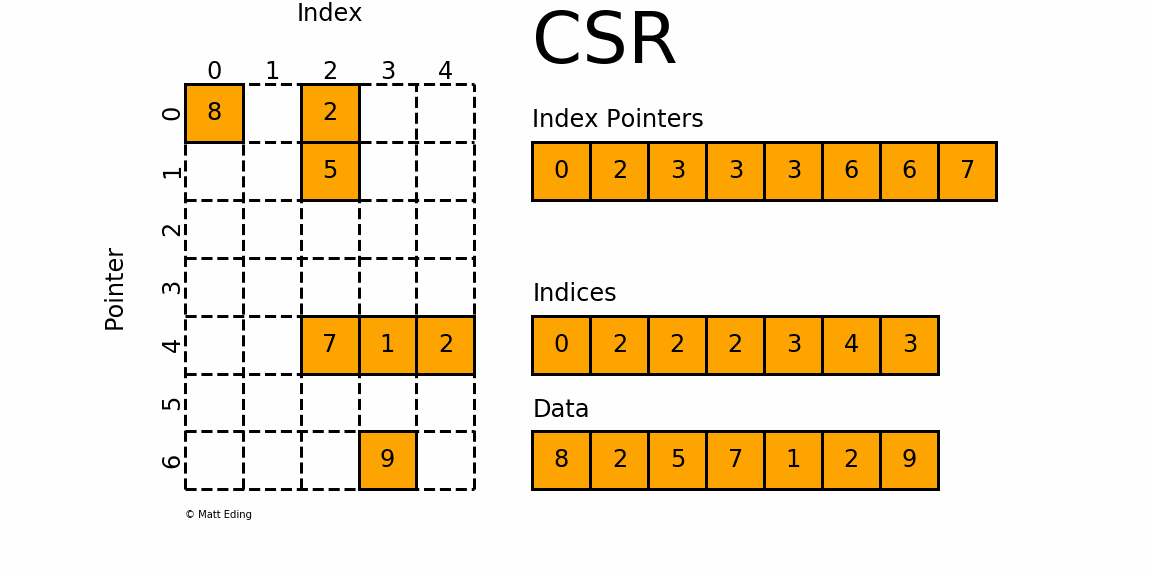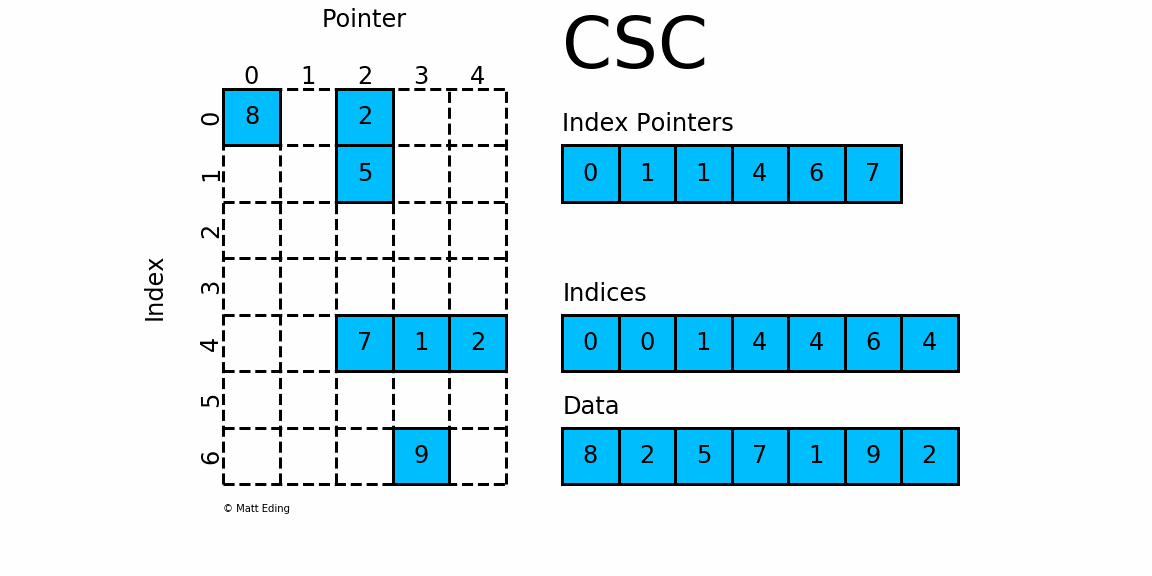@TOC
稀疏矩阵的格式
目前,torch.sparse和scipy.sparse模块比较支持的主流的稀疏矩阵格式有coo格式、csr格式和csc格式,这三种格式中可供使用的API也最多。
coo
将矩阵中非零元素的坐标和值分开存储在3个数组中,3个数组长度必须相同,表示有n个非零元素。
csr
分 Index Pointers、Indices、Data3个数组存储。
Index Pointers:第i个元素记录这个矩阵的第i行的第1个非零值在Data数组的起始位置,第i+1个元素记录这个矩阵的第i行的最后一个非零值在Data数组的终止位置(不包含右边界)。因此,这个矩阵的行数等于len(Index Pointers)-1,第i行非零值的个数等于Index Pointers[i+1]-Index Pointers[i]。Indices:第i个元素记录这个矩阵的第i个非零值的列坐标。Data:第i个元素记录这个矩阵的第i个非零值的具体数值,排列顺序严格按照行优先,列次先。
csc
与csr唯一的不同在于列优先,其他规则一模一样。
Construction of Sparse COO tensors
- 常规构建
>>> i = [[0, 1, 1],
[2, 0, 2]]
>>> v = [3, 4, 5]
>>> s = torch.sparse_coo_tensor(i, v, (2, 3))
>>> s
tensor(indices=tensor([[0, 1, 1],
[2, 0, 2]]),
values=tensor([3, 4, 5]),
size=(2, 3), nnz=3, layout=torch.sparse_coo)
>>> s.to_dense()
tensor([[0, 0, 3],
[4, 0, 5]])
torch中,稀疏矩阵的存储方式记录在 tensor.layout中,可以通过检查 torch.layout == torch.sparse_coo来判断是否是coo张量。此外,稠密张量的 layout等于 strided。
- 稠密混合的coo张量
>>> i = [[0, 1, 1],
[2, 0, 2]]
>>> v = [[3, 4], [5, 6], [7, 8]]
>>> s = torch.sparse_coo_tensor(i, v, (2, 3, 2))
>>> s
tensor(indices=tensor([[0, 1, 1],
[2, 0, 2]]),
values=tensor([[3, 4],
[5, 6],
[7, 8]]),
size=(2, 3, 2), nnz=3, layout=torch.sparse_coo)
此方案与常规的coo构建方式不同,values中每个元素可以是一个向量,表示对应坐标的稠密张量,因此,创建出的coo张量也多出了一个维度。
- 带有重复坐标的coo张量
>>> i = [[1, 1]]
>>> v = [3, 4]
>>> s=torch.sparse_coo_tensor(i, v, (3,))
>>> s
tensor(indices=tensor([[1, 1]]),
values=tensor( [3, 4]),
size=(3,), nnz=2, layout=torch.sparse_coo)
>>> s.to_dense()
tensor([0, 7, 0])
如果输入的坐标有重复,则创建出的coo张量会自动把坐标重复的元素值相加。此外,可以通过成员函数 .coalesce()把重复坐标的元素值相加,将这个coo转换成一个不重复的张量;也可以通过 .is_coalesced()检查这个coo是否存在重复的坐标。
Construction of CSR tensors
按照 Index Pointers、Indices、Data三个数组的定义构建即可。
>>> crow_indices = torch.tensor([0, 2, 4])
>>> col_indices = torch.tensor([0, 1, 0, 1])
>>> values = torch.tensor([1, 2, 3, 4])
>>> csr = torch.sparse_csr_tensor(crow_indices, col_indices, values, dtype=torch.float64)
>>> csr
tensor(crow_indices=tensor([0, 2, 4]),
col_indices=tensor([0, 1, 0, 1]),
values=tensor([1., 2., 3., 4.]), size=(2, 2), nnz=4,
dtype=torch.float64)
>>> csr.to_dense()
tensor([[1., 2.],
[3., 4.]], dtype=torch.float64)
Linear Algebra operations(稀疏与稠密之间混合运算)
M表示2-D张量,V表示1-D张量,f表示标量,*表示逐元素乘法,@表示矩阵乘法。M[SparseSemiStructured]表示一种半结构化的稀疏矩阵,此处不再展开,可以自行去torch官网察看。
| PyTorch operation | Sparse grad | Layout signature |
|---|---|---|
| torch.mv() | no | M[sparse_coo] @ V[strided] -> V[strided] |
| torch.mv() | no | M[sparse_csr] @ V[strided] -> V[strided] |
| torch.matmul() | no | M[sparse_coo] @ M[strided] -> M[strided] |
| torch.matmul() | no | M[sparse_csr] @ M[strided] -> M[strided] |
| torch.matmul() | no | M[SparseSemiStructured] @ M[strided] -> M[strided] |
| torch.matmul() | no | M[strided] @ M[SparseSemiStructured] -> M[strided] |
| torch.mm() | no | M[strided] @ M[SparseSemiStructured] -> M[strided] |
| torch.mm() | no | M[sparse_coo] @ M[strided] -> M[strided] |
| torch.mm() | no | M[SparseSemiStructured] @ M[strided] -> M[strided] |
| torch.sparse.mm() | yes | M[sparse_coo] @ M[strided] -> M[strided] |
| torch.smm() | no | M[sparse_coo] @ M[strided] -> M[sparse_coo] |
| torch.hspmm() | no | M[sparse_coo] @ M[strided] -> M[hybrid sparse_coo] |
| torch.bmm() | no | T[sparse_coo] @ T[strided] -> T[strided] |
| torch.addmm() | no | f * M[strided] + f * (M[sparse_coo] @ M[strided]) -> M[strided] |
| torch.addmm() | no | f * M[strided] + f * (M[SparseSemiStructured] @ M[strided]) -> M[strided] |
| torch.addmm() | no | f * M[strided] + f * (M[strided] @ M[SparseSemiStructured]) -> M[strided] |
| torch.sparse.addmm() | yes | f * M[strided] + f * (M[sparse_coo] @ M[strided]) -> M[strided] |
| torch.sspaddmm() | no | f * M[sparse_coo] + f * (M[sparse_coo] @ M[strided]) -> M[sparse_coo] |
| torch.lobpcg() | no | GENEIG(M[sparse_coo]) -> M[strided], M[strided] |
| torch.pca_lowrank() | yes | PCA(M[sparse_coo]) -> M[strided], M[strided], M[strided] |
| torch.svd_lowrank() | yes | SVD(M[sparse_coo]) -> M[strided], M[strided], M[strided] |
以上API中,如果 Layout signature中提供了 @或者 *操作符,就不需要记住API,直接通过操作符即可隐式调用对应的API。如:
>>> a = torch.tensor([[0, 0, 1, 0], [1, 2, 0, 0], [0, 0, 0, 0]], dtype=torch.float64)
>>> sp = a.to_sparse_csr()
>>> vec = torch.randn(4, 1, dtype=torch.float64)
>>> sp.matmul(vec)
tensor([[ 0.4788],
[-3.2338],
[ 0.0000]], dtype=torch.float64)
>>> sp @ vec
tensor([[ 0.4788],
[-3.2338],
[ 0.0000]], dtype=torch.float64)
需要注意的是,使用操作符在稀疏张量和稠密张量之间乘法运算时,返回的都是稠密张量。如果想要返回稀疏张量,需要显式使用torch.smm()。
torch同样支持稀疏与稀疏之间的运算,但要求输入的稀疏张量必须具有相同的稀疏结构,否则会报错,返回的稀疏张量的稀疏结构也与输入相同。
乘法运算:
>>> a = torch.tensor([[0, 0, 1, 0], [1, 2, 0, 0], [0, 1, 0, 0], [1, 0, 0, 0]], dtype=torch.float64)
>>> b = torch.tensor([[0, 0, 2, 0], [3, 1, 0, 0], [0, 0, 4, 0], [1, 0, 0, 1]], dtype=torch.float64)
>>> sp1 = a.to_sparse_coo()
>>> sp2 = b.to_sparse_coo()
>>> sp1 @ sp2
tensor(indices=tensor([[0, 1, 1, 1, 2, 2, 3],
[2, 0, 1, 2, 0, 1, 2]]),
values=tensor([4., 6., 2., 2., 3., 1., 2.]),
size=(4, 4), nnz=7, dtype=torch.float64, layout=torch.sparse_coo)
加法运算
>>> a = torch.tensor([[0, 0, 1, 0], [1, 2, 0, 0], [0, 1, 0, 0], [1, 0, 0, 0]], dtype=torch.float64)
>>> b = torch.tensor([[0, 0, 2, 0], [3, 1, 0, 0], [0, 0, 4, 0], [1, 0, 0, 1]], dtype=torch.float64)
>>> sp1 = a.to_sparse_coo()
>>> sp2 = b.to_sparse_coo()
>>> sp3 = b.to_sparse_csr()
>>> sp1 + sp2
tensor(indices=tensor([[0, 1, 1, 2, 2, 3, 3],
[2, 0, 1, 1, 2, 0, 3]]),
values=tensor([3., 4., 3., 1., 4., 2., 1.]),
size=(4, 4), nnz=7, dtype=torch.float64, layout=torch.sparse_coo)
>>> sp1 + sp3
UserWarning: Sparse CSR tensor support is in beta state. If you miss a functionality in the sparse tensor support, please submit a feature request to https://github.com/pytorch/pytorch/issues. (Triggered internally at C:\actions-runner\_work\pytorch\pytorch\builder\windows\pytorch\aten\src\ATen\SparseCsrTensorImpl.cpp:55.)
sp3 = b.to_sparse_csr()
Traceback (most recent call last):
File "C:\Users\Xu Han\Desktop\pycharm-projects\MD_notes\main.py", line 18, in <module>
print(sp1 + sp3)
RuntimeError: memory format option is only supported by strided tensors
Tensor methods and sparse(与稀疏有关的tensor成员函数)
| PyTorch operation | return |
|---|---|
| Tensor.is_sparse | IsTrue if the Tensor uses sparse COO storage layout, False otherwise. |
| Tensor.is_sparse_csr | IsTrue if the Tensor uses sparse CSR storage layout, False otherwise. |
| Tensor.dense_dim | Return the number of dense dimensions in a sparse tensorself. |
| Tensor.sparse_dim | Return the number of sparse dimensions in a sparse tensorself. |
这里打断一下表格,讲解一下dense_dim和sparse_dim的含义。上文中,我们曾构建过稠密混合的coo张量,如下:
>>> i = [[0, 1, 1],
[2, 0, 2]]
>>> v = [[3, 4], [5, 6], [7, 8]]
>>> s = torch.sparse_coo_tensor(i, v, (2, 3, 2))
>>> s
tensor(indices=tensor([[0, 1, 1],
[2, 0, 2]]),
values=tensor([[3, 4],
[5, 6],
[7, 8]]),
size=(2, 3, 2), nnz=3, layout=torch.sparse_coo)
那么,对于这个tensor,它的dense_dim为1,sparse_dim为2。
此外,在进行稀疏与稀疏之间的数学运算时,一定要保证稀疏张量的sparse_dim等于2.
继续表格。
| PyTorch operation | return |
|---|---|
| Tensor.sparse_mask | Returns a new sparse tensor with values from a strided tensorself filtered by the indices of the sparse tensor mask. |
| Tensor.to_sparse | Returns a sparse copy of the tensor. |
| Tensor.to_sparse_coo | Convert a tensor to coordinate format. |
| Tensor.to_sparse_csr | Convert a tensor to compressed row storage format (CSR). |
| Tensor.to_sparse_csc | Convert a tensor to compressed column storage (CSC) format. |
| Tensor.to_sparse_bsr | Convert a tensor to a block sparse row (BSR) storage format of given blocksize. |
| Tensor.to_sparse_bsc | Convert a tensor to a block sparse column (BSC) storage format of given blocksize. |
| Tensor.to_dense | Creates a strided copy ofself if self is not a strided tensor, otherwise returns self. |
| Tensor.values | Return the values tensor of a sparse COO tensor. |
以下是仅限coo张量的成员:
| PyTorch operation | return |
|---|---|
| Tensor.coalesce | Returns a coalesced copy ofself if self is an uncoalesced tensor. |
| Tensor.sparse_resize_ | Resizesself sparse tensor to the desired size and the number of sparse and dense dimensions. |
| Tensor.sparse_resize_and_clear_ | Removes all specified elements from a sparse tensorself and resizes self to the desired size and the number of sparse and dense dimensions. |
| Tensor.is_coalesced | ReturnsTrue if self is a sparse COO tensor that is coalesced, False otherwise. |
| Tensor.indices | Return the indices tensor of a sparse COO tensor. |
以下是仅限csr和bsr张量的成员:
| PyTorch operation | return |
|---|---|
| Tensor.crow_indices | Returns the tensor containing the compressed row indices of theself tensor when self is a sparse CSR tensor of layout sparse_csr. |
| Tensor.col_indices | Returns the tensor containing the column indices of theself tensor when self is a sparse CSR tensor of layout sparse_csr. |
以下是仅限csc和bsc张量的成员:
| PyTorch operation | return |
|---|---|
| Tensor.row_indices | … |
| Tensor.ccol_indices | … |
coo张量可用的tensor成员函数(经实测,csr也有一些可以用,比如dim())
add() add_() addmm() addmm_() any() asin() asin_() arcsin() arcsin_() bmm() clone() deg2rad() deg2rad_() detach() detach_() dim() div() div_() floor_divide() floor_divide_() get_device() index_select() isnan() log1p() log1p_() mm() mul() mul_() mv() narrow_copy() neg() neg_() negative() negative_() numel() rad2deg() rad2deg_() resize_as_() size() pow() sqrt() square() smm() sspaddmm() sub() sub_() t() t_() transpose() transpose_() zero_()
Torch functions specific to sparse Tensors(与稀疏有关的torch函数)
| PyTorch operation | return |
|---|---|
| sparse_coo_tensor | Constructs a sparse tensor in COO(rdinate) format with specified values at the givenindices. |
| sparse_csr_tensor | Constructs a sparse tensor in CSR (Compressed Sparse Row) with specified values at the givencrow_indices and col_indices. |
| sparse_csc_tensor | Constructs a sparse tensor in CSC (Compressed Sparse Column) with specified values at the givenccol_indices and row_indices. |
| sparse_bsr_tensor | Constructs a sparse tensor in BSR (Block Compressed Sparse Row)) with specified 2-dimensional blocks at the givencrow_indices and col_indices. |
| sparse_bsc_tensor | Constructs a sparse tensor in BSC (Block Compressed Sparse Column)) with specified 2-dimensional blocks at the givenccol_indices and row_indices. |
| sparse_compressed_tensor | Constructs a sparse tensor in Compressed Sparse format - CSR, CSC, BSR, or BSC - with specified values at the givencompressed_indices and plain_indices. |
| sparse.sum | Return the sum of each row of the given sparse tensor. |
| sparse.addmm | This function does exact same thing as torch.addmm() in the forward, except that it supports backward for sparse COO matrixmat1. |
| sparse.sampled_addmm | Performs a matrix multiplication of the dense matricesmat1 and mat2 at the locations specified by the sparsity pattern of input. |
| sparse.mm | Performs a matrix multiplication of the sparse matrixmat1 |
| sspaddmm | Matrix multiplies a sparse tensormat1 with a dense tensor mat2, then adds the sparse tensor input to the result. |
| hspmm | Performs a matrix multiplication of a sparse COO matrixmat1 and a strided matrix mat2. |
| smm | Performs a matrix multiplication of the sparse matrixinput with the dense matrix mat. |
| sparse.softmax | Applies a softmax function. |
| sparse.log_softmax | Applies a softmax function followed by logarithm. |
| sparse.spdiags | Creates a sparse 2D tensor by placing the values from rows ofdiagonals along specified diagonals of the output |
支持稀疏张量的常规torch函数
cat() dstack() empty() empty_like() hstack() index_select() is_complex() is_floating_point() is_nonzero() is_same_size() is_signed() is_tensor() lobpcg() mm() native_norm() pca_lowrank() select() stack() svd_lowrank() unsqueeze() vstack() zeros() zeros_like()
支持稀疏张量的一元函数
The following operators currently support sparse COO/CSR/CSC/BSR tensor inputs.
abs() asin() asinh() atan() atanh() ceil() conj_physical() floor() log1p() neg() round() sin() sinh() sign() sgn() signbit() tan() tanh() trunc() expm1() sqrt() angle() isinf() isposinf() isneginf() isnan() erf() erfinv()
本文由博客一文多发平台 OpenWrite 发布!
共同学习,写下你的评论
评论加载中...
作者其他优质文章








